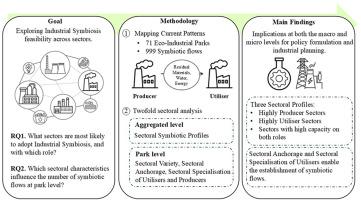Industrial symbiosis patterns in eco-industrial parks: A sectoral analysis based on global empirical data
IF 10
1区 环境科学与生态学
Q1 ENGINEERING, ENVIRONMENTAL
引用次数: 0
Abstract
Industrial Symbiosis is a recognised model for promoting sustainable production systems. Its feasibility varies significantly depending on the sector. Only a limited number of studies have addressed Industrial Symbiosis from a sectoral perspective, thereby hindering the capabilities of policymakers to make informed decisions about sectoral regulations and investments. The present study utilises Eco-Industrial Parks as a unit of analysis, enabling an in-depth investigation of their sectoral structures and the mapping of current symbiotic patterns worldwide. The aim of the study is twofold: (i) to provide a comprehensive evaluation of the feasibility of Industrial Symbiosis across sectors, with the aim of identifying which economic sectors are more likely to be involved in symbiotic exchanges and with which role; and (ii) to provide additional insights into the sectoral characteristics at the park level that enable symbiotic performance, in terms of the number of established flows. 999 symbiotic flows occurring within 71 parks are mapped and analysed using different statistical tools. At the park level, a multiple linear regression is employed to understand how symbiotic performance can be affected by sectoral variety, sectoral anchorage, sectoral specialisation of producers, and sectoral specialisation of utilisers. The study offers useful implications to inform decision-making at both the macro and micro levels, in terms of funding allocation, framework agreements and industrial planning. Not only does it draw symbiotic sectoral profiles and highlight the sectors most engaged in symbiotic activities, but it also uncovers the structural sectoral characteristics of parks that enhance the establishment of symbiotic flows.

生态工业园区产业共生模式:基于全球经验数据的行业分析
工业共生是促进可持续生产系统的公认模式。其可行性因行业而异。只有数量有限的研究从部门角度讨论了工业共生问题,从而阻碍了决策者就部门法规和投资作出知情决定的能力。本研究利用生态工业园区作为分析单元,对其部门结构进行深入调查,并绘制全球当前的共生模式。这项研究的目的是双重的:(i)提供一个跨部门的工业共生的可行性的综合评价,目的是确定哪些经济部门更有可能参与共生交流,并与哪个角色;(ii)就已建立的流量数量而言,为园区层面的部门特征提供更多见解,以实现共生绩效。使用不同的统计工具绘制和分析了71个公园内的999种共生流动。在园区层面,采用多元线性回归来了解共生绩效如何受到部门多样性、部门锚地、生产者部门专业化和使用者部门专业化的影响。这项研究在资金分配、框架协议和工业规划方面为宏观和微观两级的决策提供了有益的启示。它不仅绘制了共生的部门概况,突出了从事共生活动最多的部门,而且还揭示了促进共生流动建立的公园的结构性部门特征。
本文章由计算机程序翻译,如有差异,请以英文原文为准。
求助全文
约1分钟内获得全文
求助全文
来源期刊

Journal of Cleaner Production
环境科学-工程:环境
CiteScore
20.40
自引率
9.00%
发文量
4720
审稿时长
111 days
期刊介绍:
The Journal of Cleaner Production is an international, transdisciplinary journal that addresses and discusses theoretical and practical Cleaner Production, Environmental, and Sustainability issues. It aims to help societies become more sustainable by focusing on the concept of 'Cleaner Production', which aims at preventing waste production and increasing efficiencies in energy, water, resources, and human capital use. The journal serves as a platform for corporations, governments, education institutions, regions, and societies to engage in discussions and research related to Cleaner Production, environmental, and sustainability practices.
 求助内容:
求助内容: 应助结果提醒方式:
应助结果提醒方式:


